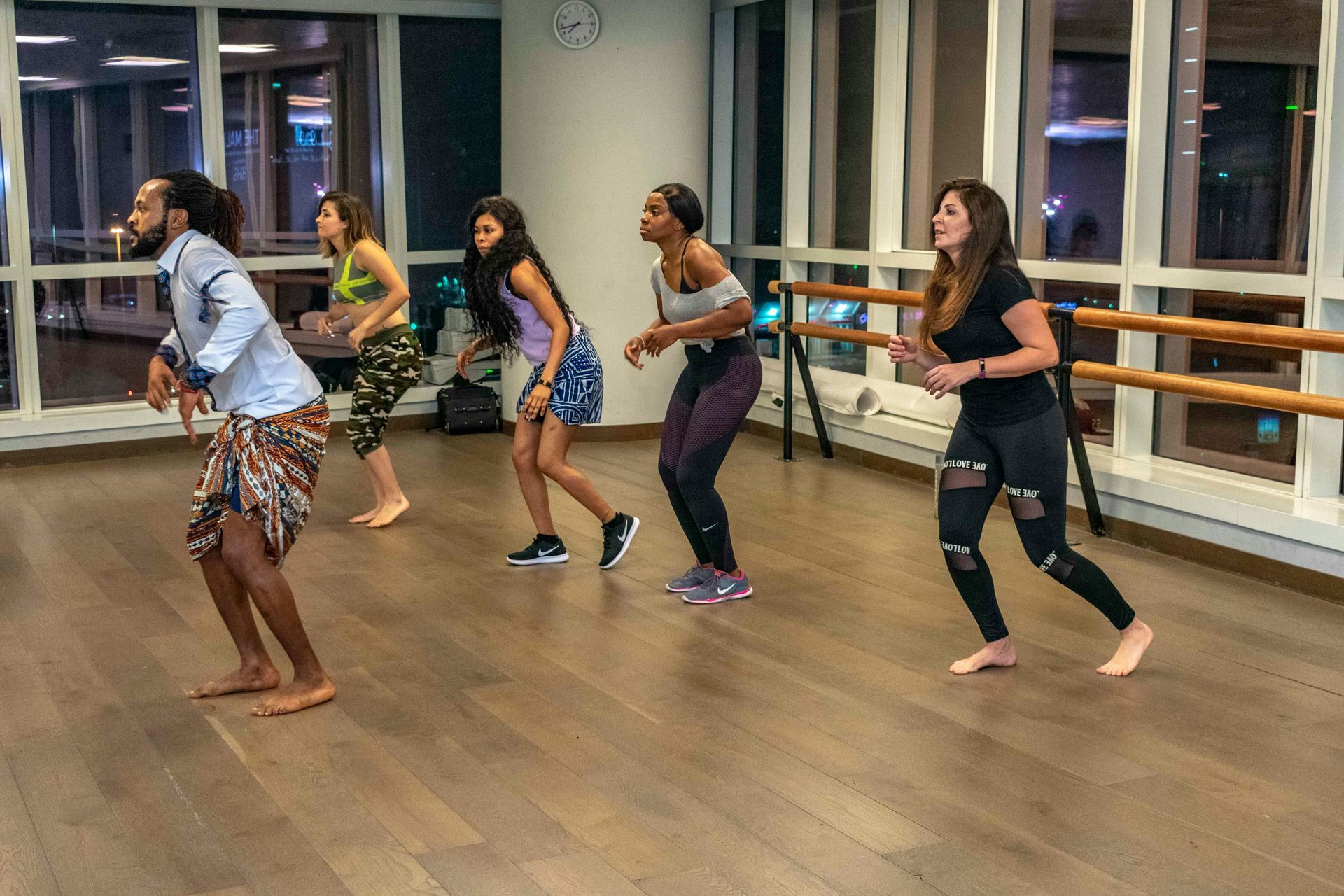Choosing the Right Dance Shoes
Whether you're stepping into ballroom dancing or exploring
adult dance classes
in a Victoria Tx dance studio, the right dance shoes can transform your entire experience. Proper footwear serves as the foundation for every dancer's journey, providing essential support and enhancing confidence on the dance floor. Understanding how to select the perfect pair becomes crucial for both beginners and experienced dancers.
Key Takeaways
- Dance shoes with suede or leather soles provide the ideal balance of grip and slide needed for proper technique across all dance styles
- Proper heel height varies by dance style, with 1.5-2 inch heels optimal for ballroom and Latin dances, while lower heels work better for swing and country dances
- Fit is paramount: dance shoes should feel snug but comfortable, with about a quarter-inch of space at the longest toe to prevent sliding during turns
- Quality construction with reinforced stitching and flexible materials ensures shoes can withstand regular practice sessions and social dancing
- Breaking in new dance shoes gradually and maintaining them properly extends their lifespan and maintains optimal performance
- Budget considerations should balance initial cost with durability, as investing in quality dance shoes often proves more economical long-term
Understanding Dance Shoe Basics
Dance shoes differ significantly from regular street shoes in both design and function. The most distinctive feature lies in the sole construction, which typically incorporates suede or specialized leather to create the perfect balance of slip and grip. This allows dancers to glide smoothly while maintaining enough traction for controlled movements and stops.
Quality dance shoes include several essential components: soles that extend slightly beyond the heel and toe areas for stability, flexible upper materials like leather or satin, and reinforced stitching at stress points. Professional dance instructors often emphasize that proper footwear directly impacts learning progression, as specialized construction allows for proper foot placement and reduces injury risk.
Dance Style Specific Considerations
Ballroom Dance Requirements
Ballroom dancing encompasses elegant styles like waltz, foxtrot, and tango, requiring shoes that support graceful movement and precise footwork. Women typically benefit from 1.5 to 2-inch heels that provide elegance while maintaining stability. The heel should be sturdy enough for weight support during dips while allowing smooth movement.
Men's ballroom shoes traditionally feature lower heels around half an inch, with wider soles for stability during leading movements. The leather or suede sole must allow controlled sliding during progressive movements while providing grip for stationary figures. Many dancers prefer split sole designs for increased foot flexibility.
Latin Dance Footwear
Latin dances such as salsa, rumba, and cha-cha demand shoes that accommodate quick weight changes and directional shifts. Women's Latin shoes typically feature higher heels ranging from 2.5 to 3.5 inches, facilitating characteristic hip action and leg lines. The heel should be positioned under the arch for proper balance during rapid movements and spins.
Ankle straps become particularly important for Latin shoes, providing security during fast-paced movements and preventing foot sliding. Adult dance classes focusing on Latin styles often recommend adjustable straps for a custom fit that accommodates foot changes during extended practice.
Swing and Country Dance Options
Swing dancing and country Western styles require shoes that handle energetic movements, quick direction changes, and occasional floor work. These styles benefit from lower heel heights, typically flat to 1.5 inches, providing stability for bouncing and kicking motions in swing and sliding movements in country dancing.
Durability becomes key for swing and country shoes due to high-energy movement. Reinforced toe areas withstand wear from kicks and taps, while flexible construction allows foot articulation during complex footwork. Many dancers prefer slightly thicker soles for additional cushioning during high-impact movements.
Proper Fit and Sizing
Achieving the correct fit in dance shoes requires understanding that these specialized shoes fit differently from everyday footwear. Dance shoes should feel snug around the heel and instep while allowing about a quarter-inch of space beyond the longest toe. This prevents foot sliding during turns while avoiding discomfort during extended wear.
Professional instructors typically advise trying shoes later in the day when feet are slightly swollen, mimicking dance session conditions. The width proves equally important as length, with the ball of the foot sitting comfortably in the shoe's widest part. Breaking in new shoes requires patience and gradual wear to prevent blisters, typically taking one to two weeks of increasing wear time.
Dance Shoe Style Comparison
| Dance Style | Recommended Heel Height | Sole Type | Key Features |
|---|---|---|---|
| Ballroom (Waltz, Foxtrot) | 1.5-2 inches (women) | Suede or leather | Closed toe, secure fit |
| Latin (Salsa, Cha-cha) | 2.5-3.5 inches (women) | Suede | Open toe, ankle strap |
| Swing/Country | 0.5-1.5 inches | Leather or rubber | Reinforced toe, flexible |
Material and Construction Quality
Materials used in dance shoe construction directly impact performance and longevity. High-quality leather uppers provide durability while allowing breathability during extended wear. Leather also molds to the foot over time, creating a custom fit. Satin uppers offer elegance for formal events but require more careful handling.
Sole construction represents the most critical quality aspect. Genuine suede soles provide an ideal slip and grip combination, allowing smooth gliding with maintained control. Quality construction includes reinforced stitching at stress points, flexible shank materials supporting the arch, and proper heel attachment methods for safety and performance.
Comfort Features and Support
Modern dance shoes incorporate comfort features for extended wear during practice and social dancing. Cushioned insoles absorb impact while arch support maintains proper alignment. Memory foam or gel padding in pressure points reduces fatigue during long sessions. Ankle support varies by style, with adjustable straps allowing customization for individual needs.
Budget Considerations and Value
Dance shoe pricing varies significantly based on construction quality, materials, and brand reputation. Entry-level shoes suitable for beginners attending ballroom dance lessons typically range from moderate pricing, offering basic features necessary for learning proper technique while keeping initial investment reasonable.
Intermediate dancers practicing regularly often find that higher-quality footwear provides better long-term value. Quality construction extends shoe lifespan while superior materials enhance performance and comfort. Many experienced dancers calculate cost per wear, finding higher initial investment often results in lower long-term costs. Professional-level shoes offer unmatched performance and durability for serious dancers.
Maintenance and Longevity
Proper maintenance significantly extends dance shoe lifespan while maintaining optimal performance. Regular suede sole brushing removes debris and restores texture for consistent slip characteristics. Leather conditioning prevents cracking, while careful satin storage prevents damage. Rotating between multiple pairs allows adequate drying time, preventing premature wear and odor while maximizing investment value.
Professional Recommendations and Expert Advice
Experienced dance instructors consistently emphasize trying on dance shoes in person whenever possible, as sizing varies significantly between manufacturers. Testing shoes during actual movement differs greatly from static fitting, making it valuable to perform basic steps while evaluating potential purchases. Many studios maintain relationships with suppliers who understand local dancers' needs and provide personalized fitting advice.
Timing purchases around your dance journey proves beneficial for performance and budget. Beginners may start with basic shoes to determine preferences before investing in specialized footwear. As dancers progress, their understanding of requirements becomes refined, allowing better-informed decisions. Building a collection starts with versatile shoes for primary styles, then expands to address different occasions and dance genres.
Frequently Asked Questions
How do I know if my dance shoes fit properly?
Your dance shoes should feel snug but not tight, with about a quarter-inch of space beyond your longest toe. The heel should not slip when you walk, and there should be no pressure points or pinching anywhere on your foot.
Can I wear regular shoes for dance classes?
While you can start with regular shoes, proper dance shoes significantly improve your experience and safety. Regular shoes lack the appropriate sole material for dancing and may increase injury risk or hinder your progress in learning proper technique.
How often should I replace my dance shoes?
Replacement timing depends on usage frequency and shoe quality, but most dancers replace shoes when the sole becomes too worn to provide proper slip characteristics or when upper materials lose support. With regular use, quality dance shoes typically last 6-18 months.
What's the difference between ballroom and Latin dance shoes?
Ballroom shoes typically feature closed toes and lower heels (1.5-2 inches for women), while Latin shoes often have open toes, higher heels (2.5-3.5 inches), and ankle straps. The heel placement and sole flexibility also differ to accommodate each style's specific movement requirements.
Should I buy dance shoes online or in person?
If possible, try shoes in person first, especially for your first pair, as dance shoe sizing can vary significantly from regular shoes. Once you know your preferred brands and sizes, online shopping becomes more feasible for future purchases.
Final Thoughts
Selecting the right dance shoes represents an investment in your dancing future, enhancing both performance and enjoyment while supporting proper technique development. Whether you're beginning your dance journey with introductory ballroom lessons or advancing through complex choreography in adult dance classes, quality footwear serves as the foundation for success. Take time to understand your specific needs, try different options, and invest in shoes that will support your dancing goals. With the right dance shoes, every step becomes more confident, every turn more graceful, and every dance more enjoyable.
Take your first step in your new dancing shoes in our Victoria TX dance studio. Join your new dance class today.
Reference:
https://www.satra.com/bulletin/article.php?id=2345



